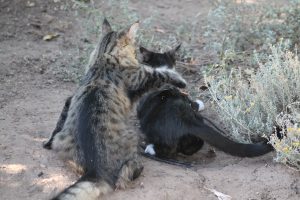 A week ago today I determined that Lily might have an ear infection—maybe even mites. Ick! Where do mites even come from? So she got another trip to the veterinarian the following Monday. I’d noticed that she was paying more attention to her ears—washing them over and over again. She wasn’t shaking her head or drooping her head like a cat will do sometimes when her ear hurts, but I sensed something was wrong, so I took a peek. Yuk. There was black stuff in there. I checked the other ear—beautiful—clean. So yes, that confirmed, there’s something going on with the one ear.
A week ago today I determined that Lily might have an ear infection—maybe even mites. Ick! Where do mites even come from? So she got another trip to the veterinarian the following Monday. I’d noticed that she was paying more attention to her ears—washing them over and over again. She wasn’t shaking her head or drooping her head like a cat will do sometimes when her ear hurts, but I sensed something was wrong, so I took a peek. Yuk. There was black stuff in there. I checked the other ear—beautiful—clean. So yes, that confirmed, there’s something going on with the one ear.
We saw a new veterinarian who had recently joined the group where I’ve been taking my cats, dogs, sheep, horses for over fifty years. Although I only have cats now and even though the original veterinarians are no longer at this clinic, we are still clients and my kitties are patients. The newest veterinarian (sorry I didn’t catch her name) said it’s a yeast infection and we are treating it with drops twice a day. Lily is behaving like a lady—in fact seemed to ask for the drops yesterday, which isn’t all that unusual because there are treats involved with the treatment.
group where I’ve been taking my cats, dogs, sheep, horses for over fifty years. Although I only have cats now and even though the original veterinarians are no longer at this clinic, we are still clients and my kitties are patients. The newest veterinarian (sorry I didn’t catch her name) said it’s a yeast infection and we are treating it with drops twice a day. Lily is behaving like a lady—in fact seemed to ask for the drops yesterday, which isn’t all that unusual because there are treats involved with the treatment.
 I’m so glad I noticed there was a problem, but I really should have noticed this sooner. We talked yesterday here at the Catscapades blog about how well cats conceal pain. It’s often impossible to know when your cat is in distress. They’re amazingly skilled actors. As I said yesterday, this is something cats have carried with them for many generations—it’s part of their survival instinct.
I’m so glad I noticed there was a problem, but I really should have noticed this sooner. We talked yesterday here at the Catscapades blog about how well cats conceal pain. It’s often impossible to know when your cat is in distress. They’re amazingly skilled actors. As I said yesterday, this is something cats have carried with them for many generations—it’s part of their survival instinct.
However, since we take cats into our homes and our hearts and vow to care for them 
 unconditionally, it’s up to us to pay close enough attention to them to make sure they’re not suffering in any way. And this isn’t easy since cats will often hide out and be very quiet when they’re suffering. As busy humans we often tend to just let them be hidey cats if that’s what the cat wants to do.
unconditionally, it’s up to us to pay close enough attention to them to make sure they’re not suffering in any way. And this isn’t easy since cats will often hide out and be very quiet when they’re suffering. As busy humans we often tend to just let them be hidey cats if that’s what the cat wants to do.
However, this in and of itself is a clue that something’s wrong. Other clues include not  eating, avoiding being petted (especially for those cats who generally love attention), any change of habit, including those related to the litter box. When you finally realize something might be wrong with your cat and you take her in for a checkup, the veterinarian will ask, “Has she been eating? Is she drinking water? Is she using the litter box?” You should be able to answer all of those questions.
eating, avoiding being petted (especially for those cats who generally love attention), any change of habit, including those related to the litter box. When you finally realize something might be wrong with your cat and you take her in for a checkup, the veterinarian will ask, “Has she been eating? Is she drinking water? Is she using the litter box?” You should be able to answer all of those questions.
I had a frail Persian cat once and I recall taking her to the veterinarian several times when there were no visible or tangible symptoms for him to diagnose. I’d have to bring her home and wait for a symptom: a fever or difficulty urinating, for example. I was so tuned into that little cat that I knew when she was sick about the same time she must have started feeling bad. But it was too early for a diagnosis. Maybe you’ve done that too.
there were no visible or tangible symptoms for him to diagnose. I’d have to bring her home and wait for a symptom: a fever or difficulty urinating, for example. I was so tuned into that little cat that I knew when she was sick about the same time she must have started feeling bad. But it was too early for a diagnosis. Maybe you’ve done that too.
 So here’s today’s lesson—watch your cat carefully. Pay attention to everything about her. Yeah, you might feel a little paranoid at times, determining, “I think she has lost a whisker,” or “Did she break a nail?” or “She left a bite in her food dish tonight, maybe she’s ill.”
So here’s today’s lesson—watch your cat carefully. Pay attention to everything about her. Yeah, you might feel a little paranoid at times, determining, “I think she has lost a whisker,” or “Did she break a nail?” or “She left a bite in her food dish tonight, maybe she’s ill.”
Now let’s not get carried away. What I want you to do is this:
- Watch for a change in habits
- Pet her all over every day looking for abnormalities

- Check her paws and under her tail when you get the chance—you don’t have to hold her down to do this, just wait for her to lay down, then take a peek.
- Look at what appears in the litter box.
You might be surprised what you find. A  sore spot on her shoulder, a claw curling around and starting to poke into the pad, lots of tiny clumps of urine in the litter box instead of one nice size clump, more vomiting than the usual occasional fur ball. You’ll know when something’s different and whether or not it requires a trip to the veterinarian.
sore spot on her shoulder, a claw curling around and starting to poke into the pad, lots of tiny clumps of urine in the litter box instead of one nice size clump, more vomiting than the usual occasional fur ball. You’ll know when something’s different and whether or not it requires a trip to the veterinarian.
What’s the alternative? I think we’ve all lived it—a cat who has probably suffered more than she needed to if only we’d taken one of her cues more seriously.






I love the photo of you with Lily. I see you’re a barefoot girl too! Yes, from watching how and how much they eat, if their activity level changes, how they interact with their surroundings, cats only give us the tiniest of clues because, you know, we might turn into a predator if we think they are weak.